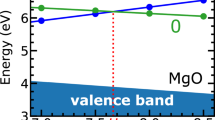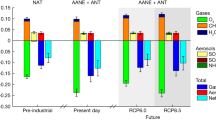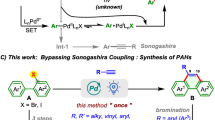Abstract
Basu and Bhattacharya1 recently claimed to have established a linear correlation between para-localization energies and polarographic half-wave potentials for some polynuclear hydrocarbons. Objections to their work have been raised by Pullman2 and Fernandez-Alonso and Domingo3, who criticize the values of the localization energies selected by Basu and Bhattacharya. All these authors use the polarographic data of Wawzonek and Laitinen4, but all of them appear to have misunderstood the latter workers' statement that polarographic reduction consists of a two-electron addition process. It is true that the overall reaction consists of the addition of two electrons. But it is clear from the work of Wawzonek and Laitinen themselves, as well as from that of later authors5–7, that the addition takes place by two one-electron steps. The least negative half-wave potential might therefore be expected to characterize the energy required to add one electron to the aromatic system, but could scarcely be related to the para-localization energy, which is a measure of the ease of addition to two positions in a hydrocarbon simultaneously8.
This is a preview of subscription content, access via your institution
Access options
Subscribe to this journal
Receive 51 print issues and online access
$199.00 per year
only $3.90 per issue
Buy this article
- Purchase on SpringerLink
- Instant access to full article PDF
Prices may be subject to local taxes which are calculated during checkout
Similar content being viewed by others
References
Basu, S., and Bhattacharya, R., J. Chem. Phys., 25, 596 (1956). Nature, 180, 143 (1957).
Pullman, A., C.R. Acad. Sci., Paris, 243, 1632 (1956).
Fernandez-Alonso, J. I., and Domingo, R., Nature, 179, 829 (1957).
Wawzonek, S., and Laitinen, H. A., J. Amer. Chem. Soc., 64, 1765, 2365 (1942).
Wawzonek, S., Blaha, E. W., Berkey, R., and Runner, M. E., J. Electrochem. Soc., 102, 235 (1955).
Hoijtink, G. J., Van Schooten, J., de Boer, E., and Aalbersberg, W. Ij., Rec. Trav. Chim., 73, 355 (1954).
Given, P. H., J. Chem. Soc. (in the press).
Brown, R. D., Quart. Rev., 6, 63 (1952).
Coulson, C. A., J. Chem. Soc., 1435 (1955).
Szwarc, M., J. Phys. Chem., 61, 40 (1957).
Matsen, F. A., J. Chem. Phys., 24, 602 (1956).
Bergman, I., Trans. Farad. Soc., 50, 829 (1954); 52, 690 (1956).
Kooyman, E. C., and Farenhorst, E., Trans. Farad. Soc., 49, 58 (1953).
Dewar, M. J. S., J. Amer. Chem. Soc., 74, 3357 (1952); J. Chem. Soc., 3581 (1956).
Hoijtink, G. J., Rec. Trav. Chim., 74, 1525 (1955).
Corey, E. J., and Sauers, C. K., J. Amer. Chem. Soc., 79, 249 (1957).
Levy, M., and Szwarc, M., J. Amer. Chem. Soc., 77, 1949 (1955). Szwarc, M., and Leavitt, F., ibid., 78, 3590 (1956).
Author information
Authors and Affiliations
Rights and permissions
About this article
Cite this article
GIVEN, P. Correlations between Localization Energies and Polarographic Half-Wave Potentials of Aromatic Hydrocarbons. Nature 181, 1001–1002 (1958). https://doi.org/10.1038/1811001a0
Issue date:
DOI: https://doi.org/10.1038/1811001a0
This article is cited by
-
Polarography of Aromatic Hydrocarbons
Nature (1959)



